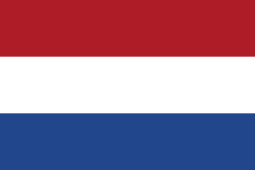 | |
| Flag of the Kingdom of the Netherlands | |
| Use | National flag and ensign |
|---|---|
| Proportion | 2:3 (not formalised by law)[1] |
| Adopted | 1575 (first full colour depiction)[2] 1596 (red replacement for orange)[3][4] 1937 (red reaffirmed)[5] 1949 (colours standardised)[6] |
| Design | A horizontal triband of red (bright vermilion), white, and cobalt blue |
| Marine Geus or Prinsengeus[7] | |
 | |
| Use | Naval jack |
| Proportion | 2:3 |
| Adopted | Late 17th c. (in use)[8] 20 April 1931 (formalised) |
| Design | 12 segments in the national colours of red (bright vermilion), white, and cobalt blue |
| Royal Standard of the Netherlands | |
 | |
| Use | Standard of the Monarch |
| Proportion | 1:1 |
| Adopted | 27 August 1908 |
| Design | Orange field divided in four by a nassau-blue cross, showing bugle-horns of the Principality of Orange and the coat of arms of the Kingdom, surrounded by a crown and the insignia of the Military Order of William. |
The national flag of the Netherlands (Dutch: de Nederlandse vlag) is a horizontal tricolour of red, white, and blue. The current design originates as a variant of the late 16th century orange-white-blue Prinsenvlag ("Prince's Flag"), evolving in the early 17th century as the red-white-blue Statenvlag ("States Flag"), the naval flag of the States-General of the Dutch Republic, making the Dutch flag the oldest tricolour flag in continuous use.[9][10][11] As a flag that symbolises the transformation from monarchy to republic, it has inspired both the derivative Russian flag, and after the French Revolution in 1789, the vertically striped French tricolour; both flags in turn influenced many other tricolours.[11][12] During the economic crisis of the 1930s, the old Prince's Flag with the colour orange gained some popularity among some people[vague]. To end the confusion, the colours red, white and blue and its official status as the national flag of the Kingdom of the Netherlands were reaffirmed by royal decree on 19 February 1937.[13]
- ^ "Neerlandia. Jaargang 61". dbnl (in Dutch). Neerlandia. 1957. Retrieved 28 January 2019.
- ^ Poels, Jos (August 2011). "The Orange Pennant: The Dutch Response to a Flag Dilemma" (PDF). Proceedings of the 24th International Congress of Vexillology, Washington, D.C., USA: 888.
- ^ State, Paul F. (2008). A Brief History of the Netherlands. Infobase Publishing. p. 51. ISBN 9781438108322.
- ^ Complete Flags of the World. Dorling Kindersley Limited. 2008. p. 121. ISBN 9781405338615.
- ^ "Flag of the Netherlands". Encyclopedia Britannica. Retrieved 3 February 2019.
- ^ "Bijlage H Maten en categorieën vlaggen Koninklijke Marine". Overheid (Dutch Government) (in Dutch). Appendix H, chapter 2. Retrieved 28 January 2019.
{{cite web}}: CS1 maint: location (link) - ^ "Maritieme kalender (April 20, 1931)" (in Dutch). Nederlands Scheepvaartmuseum. Archived from the original on 14 September 2012. Retrieved 26 August 2010.
- ^ Ham, Willem van (2016). "De Prinsengeus: een vlag voor de boeg" (PDF). Vlag! (19): 19. Retrieved 28 January 2019.
- ^ "Europe: Netherlands — The World Factbook – Central Intelligence Agency". www.cia.gov. CIA. Retrieved 28 January 2019.
- ^ Worthington, Daryl (17 October 2016). "Why Are So Many Flags Red, White and Blue?". New Historian. Retrieved 28 January 2019.
- ^ a b Flag, nation and symbolism in Europe and America. London: Routledge. 2007. p. 27. ISBN 978-1134066964.
- ^ "Flags That Look Alike | Britannica". www.britannica.com.
- ^ Cite error: The named reference
:5was invoked but never defined (see the help page).